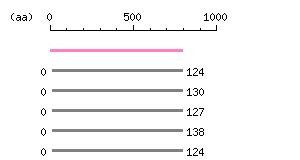
| HUGE |
Gene/Protein Characteristic Table for KIAA1310 |
|
Link to :
Rouge |
GTOP | SWISS-PROT/TrEMBL | GeneCards| RefDIC | |
| Features : DNA sequence | Protein sequence | Expression | Mapping | |
| Product ID : | ORK00212 |
|---|---|
| Accession No. : | AB037731 |
| Description : | K1310_HUMAN Isoform 4 of Q9P2N6 - Homo sapiens. |
| HUGO Gene Name : | |
| Clone Name : | fh10589 [Vector Info] |
| Flexi ORF Clone : | pF1KA1310
 |
| Source : | Human fetal brain |
Features of the cloned DNA sequence |
Description | |
|---|---|---|
Length: 5028 bp

|
| cloned DNA seq. | |
Warning for N-terminal truncation: | NO |
Warning for coding interruption: | NO |
Length of 3'UTR 2586 bp Genome contig ID gi89161199r_96522638 PolyA signal sequence
(ATTAAA,-18)
TTACATTAACAAAAACAATTAAAAACACCAAAAACFlanking genome sequence
(100000 - 99951)
AACATTTGGATTGCTTCAGCTTCTTTTCAGTTGACTTCTCATATGTATTC
Chr f/r start end exon identity class ContigView(URL based/DAS) 2 r 96622638 96667795 21 100.0 Perfect prediction
Features of the protein sequence |
Description | |
|---|---|---|
Length: 794 aa
 |
|
The numbers on the left and right sides of a black line in the graphical overview indicate the lengths (in amino acid residues) of the non-homologous N-terminal and C-terminal portions flanking the homologous region (indicated by the black line), respectively.
No significant homologues
| Motif_DB | interpro_ID | From | To | Entry | Definition |
|---|---|---|---|---|---|
| None | - | - | - | - | - |
| Method | No. | N terminal | transmembrane region | C terminal | type | length |
|---|---|---|---|---|---|---|
| - | - | - | - | - | - | - |
Expression profile |
Description | |
|---|---|---|
| RT-PCR-ELISA | Description |
|---|

Experimental conditions
| : AACTTGCACAGGGTAACAGAG | |
| : ACATCTCCATAGGGCATCAAC | |
| : 95 °C |
RH mapping information |
Description | |
|---|---|---|
| : 2 |
| : unigene | |
| : - | |
| : - | |
| : - | |
| : - |
|
How to obtain KIAA clone(s) Back to the HUGE Protein Database homepage 
| |